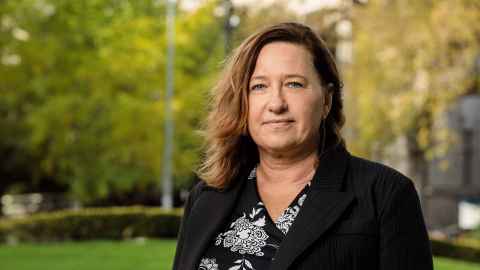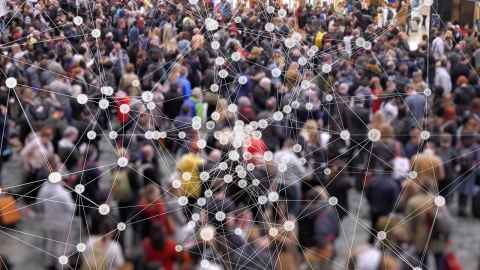NZ hosts global guardian for vaccine surveillance
24 January 2022
Aotearoa New Zealand is the host of a world-first research initiative analysing global vaccine safety surveillance data for the current pandemic and those to come.

When caught in the middle of a pandemic, the urgency of the present can wipe out recall of the recent past.
Twelve years ago, from June 2009 to August 2010, the WHO declared that the world was facing a pandemic. This global health emergency was caused by the 2009 swine flu, a particularly contagious variant of the influenza virus that sweeps through the world each year. Somewhere between 700 million and 1.4 billion people caught the swine flu and, during its course, estimates ranged of between 148,000 and 249,000 deaths on top of the deaths usually expected over that period.
New Zealand did not get off lightly. A study published in the New England Journal of Medicine found that up to 20 percent of intensive care beds in the country were used for swine flu patients at the pandemic’s height.
The surge of cases placed the hospital system under serious strain, and the same threat remains a major concern if we lose control of the Covid-19 pandemic. As with the present pandemic, vaccine campaigns became a priority with some 3 billion doses produced in 2009 to combat the spread of the swine flu.
Previous pandemics
As a vaccinologist, part of Associate Professor Helen Petousis-Harris’ job is to remember the lessons of previous pandemics.
She takes up the story. “Multiple flu vaccines were deployed and there was one vaccine used mostly in Europe where researchers observed a safety signal. However, different studies in Europe had differing results”
Reports came in of people in Nordic countries experiencing narcolepsy after receiving vaccine., Narcolepsy is a chronic sleep disorder that can see sufferers fall asleep in the middle of talking or driving.
“So, they were seeing more cases of narcolepsy than we would normally expect, and these were occurring within a short timeframe after vaccination primarily in adolescents.”
The initial evidence was circumstantial. Public health officials needed to find hard proof and so researchers began a series of studies to do the detective work to pin down the perpetrator.
Petousis-Harris says, “We needed to look across multiple populations and multiple vaccines that were being delivered to assess the risk.”
The investigations led to a vaccine Pandemrix, that featured a specific adjuvant, which is a means to enhance the impact of the vaccine. It turned out that the vaccine was working as a trigger for young people in Scandinavia who had a genetic predisposition to narcolepsy.
The narcolepsy event, she says, for the first time proved the value of multi-country, multi-vaccine studies, as a way to monitor potential serious adverse effects and further improve public confidence in the safety of vaccines.
Studies revealed that only Pandemrix had this risk while a similar sister vaccine Arepandrix used in Canada did not. It took global collaborative studies to untangle the puzzle.
The Covid-19 pandemic is by many magnitudes more serious than swine flu. It is more infectious so more widespread and much more deadly.
Before vaccines are approved for use, they progress through three phases of trials, the last phase, human clinical trials, can involve up to tens of thousands of volunteers.
Petousis-Harris says, “Vaccines are well-tested and have excellent safety profiles, but we can’t exclude very rare events without monitoring what’s happening with very large numbers of people. If there was a risk of something adverse happening as a one in two or three million chance, you need studies with scale to understand the risk.”
The Covid-19 pandemic is by many magnitudes more serious than swine flu. It is more infectious so more widespread and much more deadly. Since 2020, it has generated giant numbers that have become shorthand for tragedy and hope.
As we enter the third year of Covid-19, the virus has taken more than 5.5 million lives. On the other side of the ledger, 31.65 million doses of vaccine are administered each day.
About 9.46 billion doses have been delivered, but more than 40 per cent of the global population, mostly in low-income countries, have yet to receive their first dose.

Global problems require big-picture thinking and that has led to Aotearoa New Zealand being selected as the host of a world first-research initiative collecting global vaccine data.
The project is based on the way the narcolepsy event was evaluated 12 years ago in the swine flu pandemic. Petousis-Harris says those multi-country studies demonstrated the value of a research programme being able to collate and analyse big data from vaccine rollouts.
The Global Vaccine Data Network (GVDN) aims to be a planetwide system to assess safety issues that might arise from the more than 20 Covid-19 vaccine types in use, from
Pfizer/BioNTech and Astra Zeneca in New Zealand and Australia to the Russian Sputnik V and multiple vaccines developed and delivered in China.
Petousis-Harris of the Faculty of Medical and Health Sciences at the University of Auckland is the co-director, alongside Steven Black, a highly respected specialist in paediatric infectious diseases and vaccinology who has led major projects for the American Centres for Disease Control (CDC) and for the World Health Organization, including some of the work related to the identification of the cause of the swine flu narcolepsy event in 2009/ 2010.
Scale is just one factor. Research into vaccine safety has previously relied on countries with good data sets. It’s a limited pool that includes countries like Denmark or the United States. The GVDN is working to collect and collate vaccine safety data that more accurately reflect greater diversity in people, geography and health systems to also compare how different Covid-19 vaccines are working.
To do this, the GVDN holds major contracts from the United States Centres for Disease Control and Prevention and the Gates Foundation and has 22 partner institutions in 18 countries to date, with the number increasing as the need to do these studies is increasingly recognised.
The big data the GVDN will handle, enables researchers to act preventively, searching through big data for a ‘signal’, a sign of an unexpected issue associated with a vaccine. Petousis-Harris envisages a ‘dashboard’ visualisation of the data based on initial work to establish baseline levels of about 30 conditions that might potentially be a side effect of the vaccines.
Vaccines, created through a range of techniques, at heart, work by training and jump-starting the immune system, bolstering our natural defences against disease. After a jab, side effects can result. For Covid-19 vaccines these range from tiredness and fever to aching muscles and headaches, a small price to pay to avoid serious illness and potential death.
Rather than known more common side-effects, the GVDN is looking for serious adverse events, defined as health issues that require hospitalisation and have potential for longer-term complications.
Perhaps the best-known side effect of the Pfizer Covid-19 vaccination, particularly in men under 30, is myocarditis and pericarditis, both types of heart inflammation that cause a fast-beating heart and shortness of breath. This has led to people being hospitalised. But the risk has been justified by studies that show the risk of myocarditis caused by the vaccine is four times less than the risk of myocarditis that would come from Covid-19 infection. On top of that 400 per cent difference in risk, myocarditis related to the vaccine can normally be treated with rest, reassurance and ibuprofen, though in very rare cases, it can result in death.
Petousis-Harris says, “The fact that we’re going to be doing these huge studies will be quite reassuring to people as they provide a further element of certainty about the relationship between the vaccines and potential events.”
The researchers were able to show that the MeNZB vaccine, despite being developed for another disease, was 31 per cent effective against gonorrhoea.
How the GVDN came to be hosted in New Zealand is a quirky outcome from the world of vaccine research.
Steven Black is an eminent figure in vaccinology and epidemiology, something of a science rock star. Black had been looking at data on New Zealand’s meningococcal B immunisation programme. The programme was a necessary response to an epidemic on meningococcal disease in young people.
During the course of the epidemic, the disease led to nearly 240 deaths. From the 1990s to 2006, there were more than 5,900 cases, with 20 per cent of those affected experiencing a degree of disability, from hearing loss and brain damage to amputation and scarring.
The Ministry of Health, in partnership with the pharma company then known as Chiron, developed a vaccine MeNZB to respond to the strain present in New Zealand. Black, following data from the programme, noted that the New Zealand strain Neisseria meningitidis was similar to Neisseria gonorrhoea, the bacteria that causes the sexually transmitted disease, gonorrhoea.
Petousis-Harris was able to lead the study that proved Black’s hunch correct. By building data sets from the records for 15–30-year-olds from sexual health clinics, the researchers were able to show that the MeNZB vaccine, despite being developed for another disease, was 31 per cent effective against gonorrhoea.
The resulting research paper made the cover of The Lancet in July 2017. Prior to the discovery, efforts to produce a gonorrhoea vaccine had proved fruitless. Steve Black was a co-author and the two scientists continued to work together.
When the idea for a global vaccine data initiative was mooted and the proposal attracted major funders, Black wanted Petousis Harris as co-director. Based in different hemispheres, the collaboration works well as the two leads span time zones.
“It’s fair to say that the international research community really see value in what we’re doing here. The opportunities we have within the network for others to come join and make use of the platform we’re creating are limitless.”
Since the beginning of the 21st century, humanity has faced six significant disease threats: SARS, MERS, Ebola, bird flu, swine flu and Covid-19. Nor will Covid be the last we are likely to see in our lifetime.
Scientists fully expect further pandemics as humans take over more and more of the natural world, creating the conditions needed for new diseases from wildlife to cross over to humans. In that setting, the Global Vaccine Data Network will have an increasingly valuable role to play.
Media inquiries and re-publication requests
Gilbert Wong | Research communications manager
E: gilbert.wong@auckland.ac.nz
The article was first published by Newsroom, NZ hosts vaccine safety project